Communication Protocols
4. COMMUNICATION PROTOCOLS
The communication protocols are essential for the SCADA software to communicate with field devices. This section includes the protocol definitions and their specific settings. Channels determine the communication methods used for data transmission, ensuring the integrity of the system.
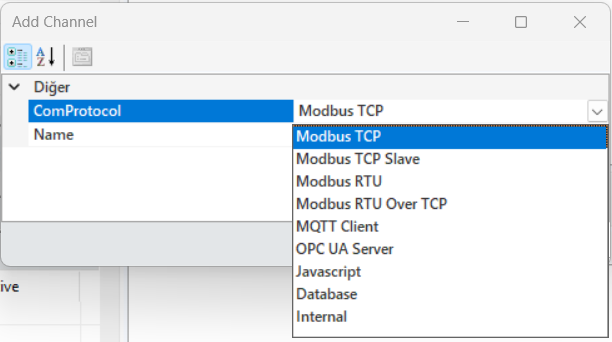
Figure 91 – Communication Protocols
All communication protocols are explained in detail in the following sections, and the processes of creating channels, frames, and tags based on these protocols are also covered.
4.1 Modbus TCP Protocol
The Modbus TCP Client acts as a client that communicates with a server via the Modbus TCP protocol. The Modbus TCP client sends requests to a Modbus TCP server and receives responses from it. The server is typically a device (e.g., a PLC), and the client is an application that reads or writes data from this device.
Modbus TCP Channel Creation
To add a channel in the Modbus TCP protocol, right-click in the "Created Channels" area in the Tag Editor and select "Add Channel."
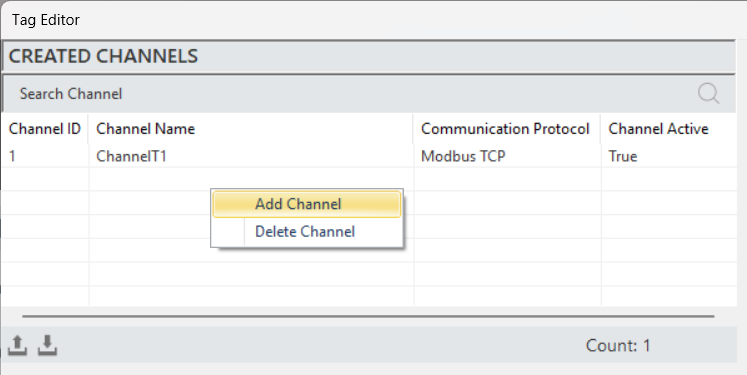
Figure 92 - Modbus TCP Channel Creation
In the opened window, select the communication protocol as "Modbus TCP," then specify the channel name to add the new channel.

Figure 93 - Modbus TCP Channel Creation
Modbus TCP Channel Structure
To access and modify channel information, when a channel is selected, all details are displayed in the "Channel Info" panel.
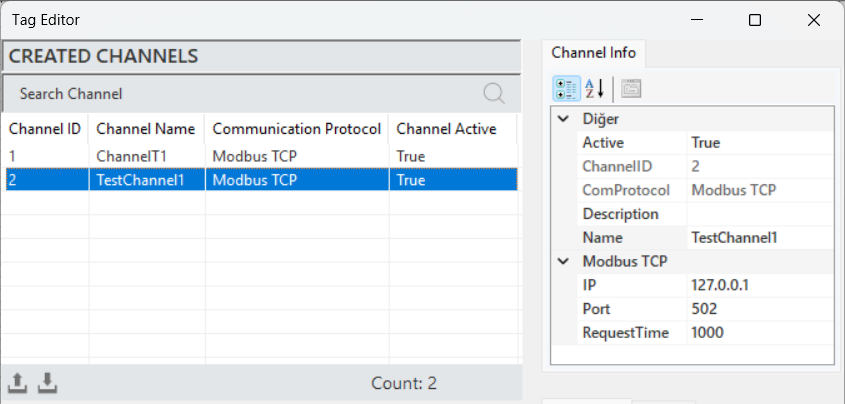
Figure 94 - Modbus TCP Channel Info
The parameter descriptions for the channel information are provided in the table below.
| “Active” | Determines whether the frame is active or inactive. |
|---|---|
| “Channel ID” | A unique identifier for the channel. |
| “Com Protocol” | Communication type information. Set when the channel is created. |
| “Description” | A description of the channel, defined according to the requirements. |
| “IP” | The IP address for communication. |
| “Port” | The port information for communication. |
| “Request Time” | The communication data response timeout in milliseconds. |
Table 7 – Modbus TCP Channel Info
Modbus TCP Frame Creation
The process of defining a new frame to structure and manage data. To create a frame, a channel must first be created. A channel is selected, and by right-clicking in the "Created Frames" section, the "Add Frame" option is clicked.
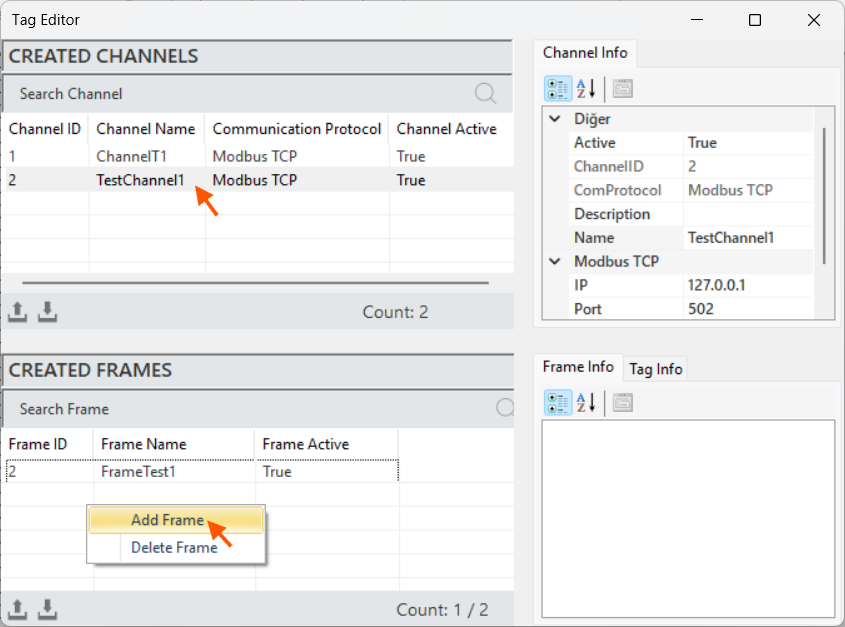
Figure 95 – Modbus TCP Frame Creation
After entering the frame information in the opened window, click "Add" to create the frame.
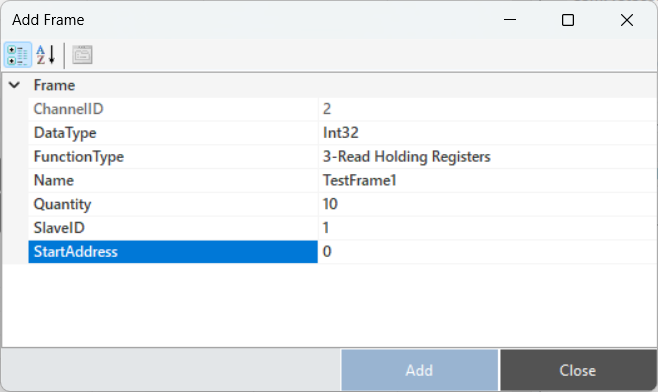
Figure 96 – Modbus TCP Frame Creation
Modbus TCP Frame Structure
When a frame is selected, all information is displayed in the "Frame Information" panel for access and editing.
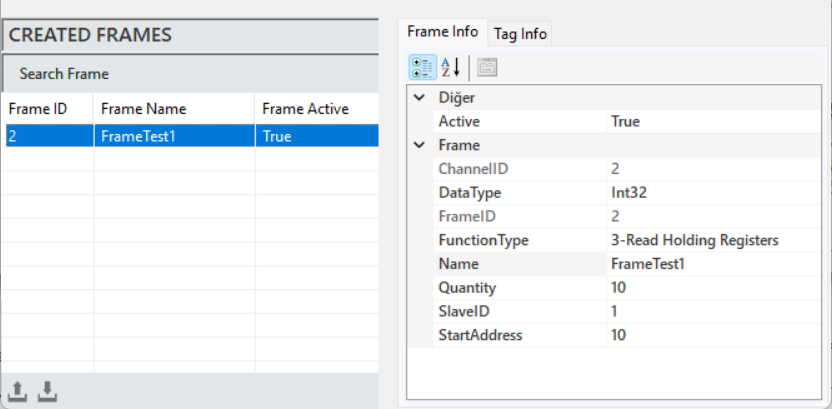
Figure 97 – Modbus TCP Frame Info
The explanations of these parameters are provided in the table below.
| “Active” | Determines whether the frame is active or inactive. |
|---|---|
| “Channel ID” | The unique channel information to which the frame is associated. |
| “Data Type” | The data type of the frame. |
| “Function Type” | The function type of the frame. |
| “Name” | The name of the frame. |
| “Quantity” | The number of data (tags) in the frame. |
| “Slave ID” | The device ID for communication. |
| “Start Address” | The starting address of the first data in the frame. |
Table 8 – Modbus TCP Frame Info
Modbus TCP Tag Creation
The process of creating a new tag that represents a specific measurement or control data. To create a tag, a frame must first be created. Once a frame is selected, right-click on the "Created Tags" area and click on "Add Tag".
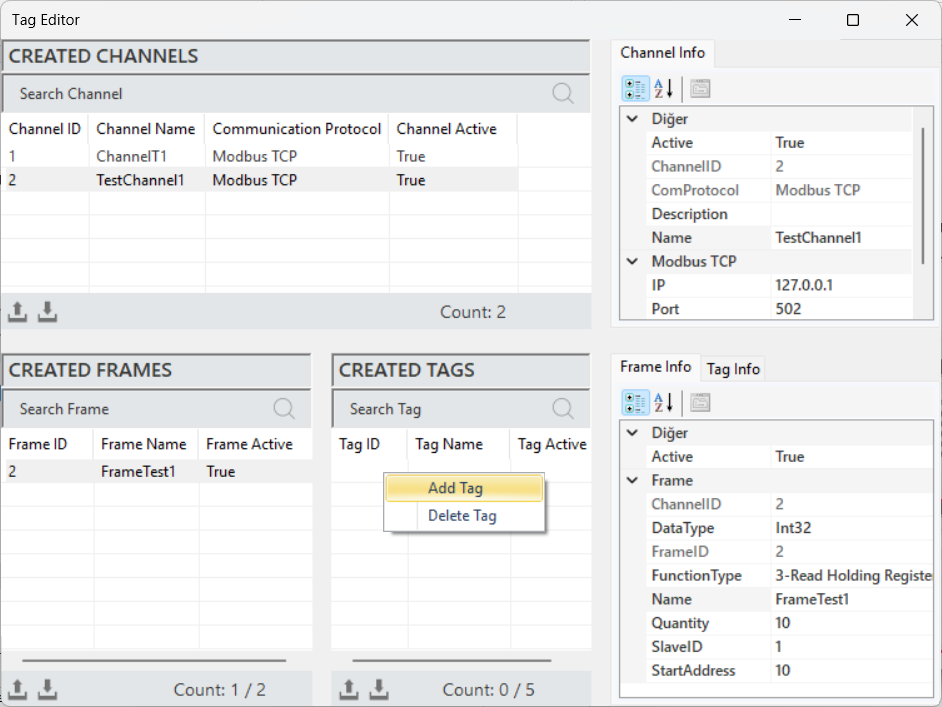
Figure 98 – Modbus TCP Tag Creation
Once the tag information is entered in the opened window, click "Add" to create the tag.
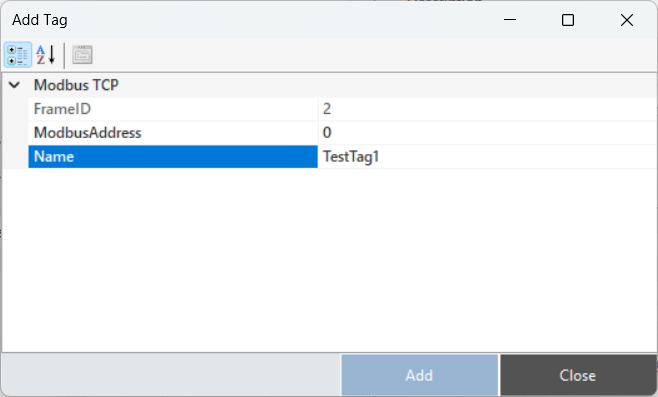
Figure 99 – Modbus TCP Tag Creation
Modbus TCP Tag Structure
To access and edit the tag information, when a tag is selected, all the details are displayed in the "Tag Info" panel.
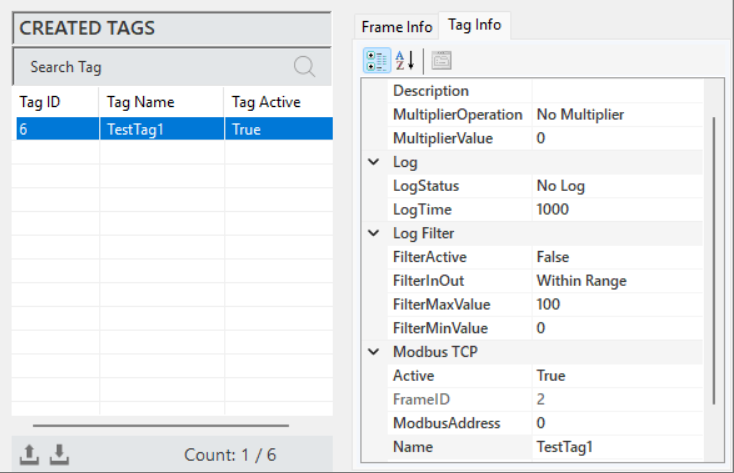
Figure 100 – Modbus TCP Tag Info
The explanations of these parameters are presented in the table below.
| "Description" | This is the label information field |
|---|---|
| "Multiplier Operation" | Used to perform any mathematical operation on the label data |
| "Multiplier Value" | Specifies the value for the operation to be applied to the label |
| "Log Status" | Indicates the log status of the label. To activate, set it to “Periodic”, and to deactivate, set it to “No Log” |
| "Log Time" | The time duration for recording label data, specified in milliseconds. |
| "Filter Active" | If filtering is required while recording label data, this command is activated. |
| "FilterInOut" | Defines whether the filter should be applied to values inside or outside the specified range. |
| "FilterMaxValue" | Specifies the maximum value in the created filter. |
| "FilterMinValue" | Specifies the minimum value in the created filter. |
| "Active" | Determines the active/inactive status of the label. |
| "Frame ID" | The identification information of the selected frame. |
| "ModbusAddress" | Specifies the address for communication of the label. |
| "Name" | This is the label name. |
| "Tag ID" | The unique identifier number that defines the channel in the figure. |
Table 9 – Modbus TCP Tag Info
4.2 Modbus TCP Slave Protocols
The Modbus TCP Slave protocol operates over TCP/IP (Transmission Control Protocol/Internet Protocol) to facilitate data exchange between a "master" device and one or more "slave" devices.
Modbus TCP uses 16-bit words for data transmission, employing structured data formats such as registers and digital inputs/outputs.
Modbus TCP Slave Channel Creation
To add a channel in the Modbus TCP Slave protocol, right-click within the "Created Channels" area and select "Add Channel”.
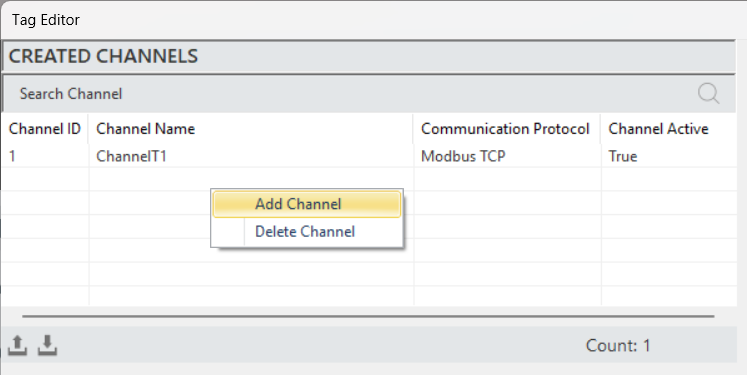
Figure 101 - Modbus TCP Slave Channel Creation
In the window that opens, select the communication protocol as "Modbus TCP Slave", specify the channel name, and then add the new channel.
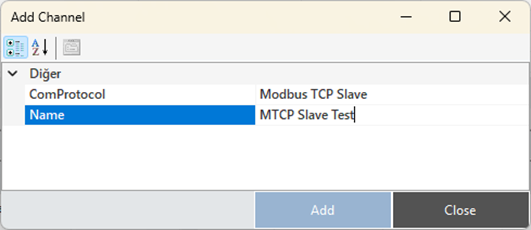
Figure 102 - Modbus TCP Slave Channel Creation
Modbus TCP Slave Channel Structure
When a channel is selected to access and make adjustments to its information, all details are reflected in the "Channel Information" panel.
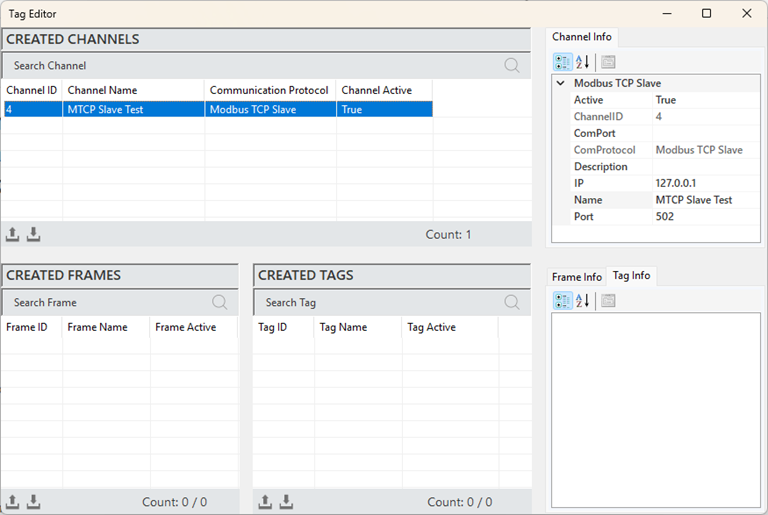
Figure 103 – Modbus TCP Slave Channel Info
The parameter descriptions are presented in the table below.
| “Active” | Determines the active/inactive status of the channel. |
|---|---|
| “Channel ID” | A unique identification number that defines the channel in a figure. |
| “Com Protocol” | The communication type. It is specified when the channel is created. |
| “Description” | The channel description. It is defined based on the requirements. |
| “IP” | The IP address through which communication will be established. |
| “Port” | The port information through which communication will be established. |
| “Request Time” | The communication data response timeout, specified in milliseconds. |
Table 10 – Modbus TCP Slave Channel Info
Modbus TCP Slave Frame Creation
It is the process of defining a new frame to organize and manage the data structure. To create a frame, a channel must first be created. A channel is selected, and then right-clicking in the "Created Frames" area allows for adding a frame.
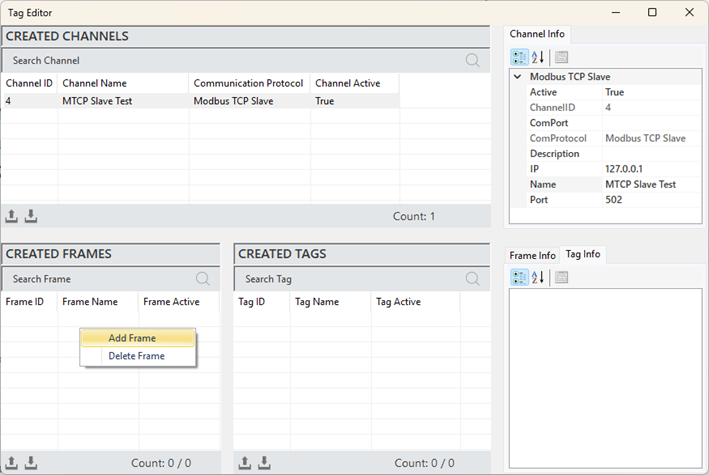
Figure 104 – Modbus TCP Slave Frame Creation
In the window that opens, after entering the frame details, click "Add" to create the frame.
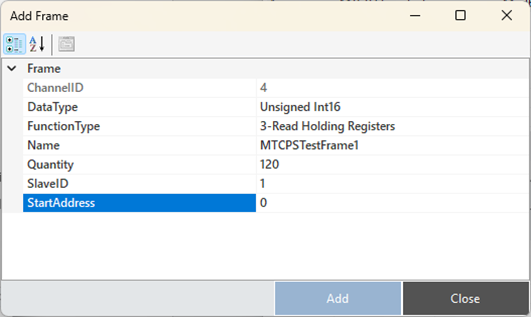
Figure 105 – Modbus TCP Slave Frame Creation
Modbus TCP Slave Frame Structure
When a frame is selected to access and make adjustments to its information, all details are reflected in the "Frame Information" panel.
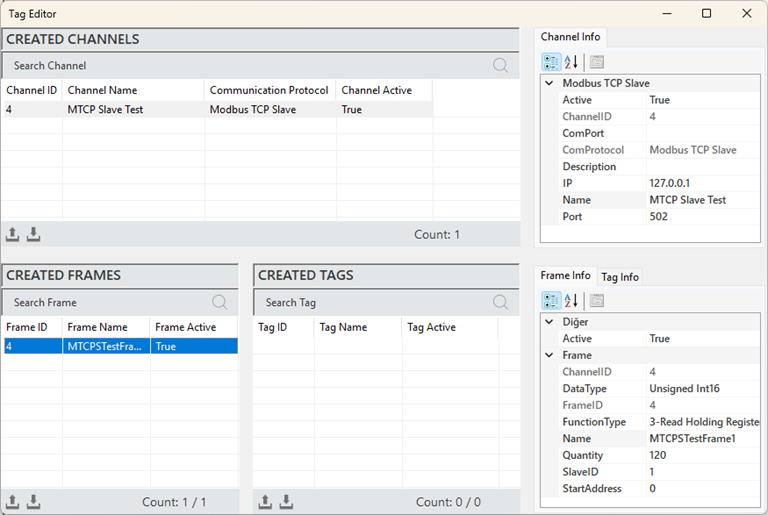
Figure 106 – Modbus TCP Slave Frame Info
The parameter descriptions are presented in the table below.
| “Active” | Determines the active/inactive status of the frame. |
|---|---|
| “Channel ID” | A unique identification number that defines the frame in a figure. |
| “Data Type” | Specifies the data type of the frame. |
| “Function Type” | Specifies the function type of the frame. |
| “Name” | The name of the frame. |
| “Quantity” | The number of data (tags) in the frame. |
| “Slave ID” | The identification number of the device to communicate with. |
| “Start Address” | The address where the first data in the frame is located, and the starting address. |
Table 11 – Modbus TCP Slave Frame Info
Modbus TCP Slave Tag Creation
It is the process of creating a new label that represents a specific measurement or control data. To create a label, a frame must first be created. A frame is selected, and then right-clicking in the "Created Tags" area allows for adding a label.
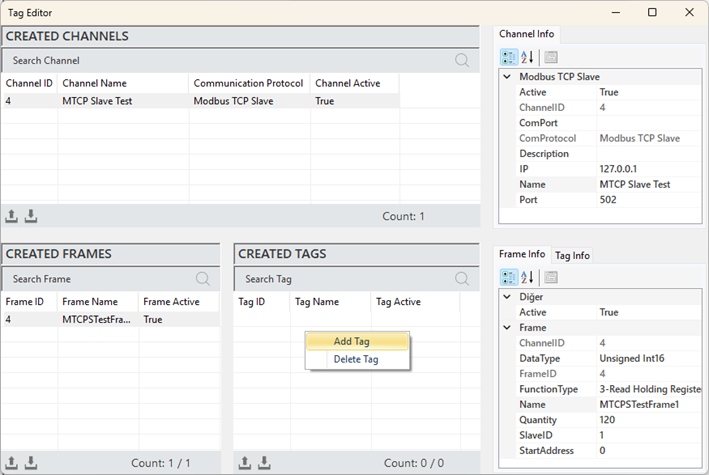
Figure 107 – Modbus TCP Slave Tag Creation
In the window that opens, after entering the label details, click "Add" to create the label.
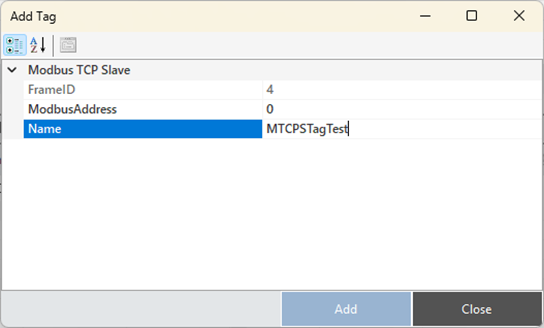
Figure 108 – Modbus TCP Slave Tag Creation
Modbus TCP Slave Tag Structure
When a label is selected to access and make adjustments to its information, all details are reflected in the "Label Information" panel.
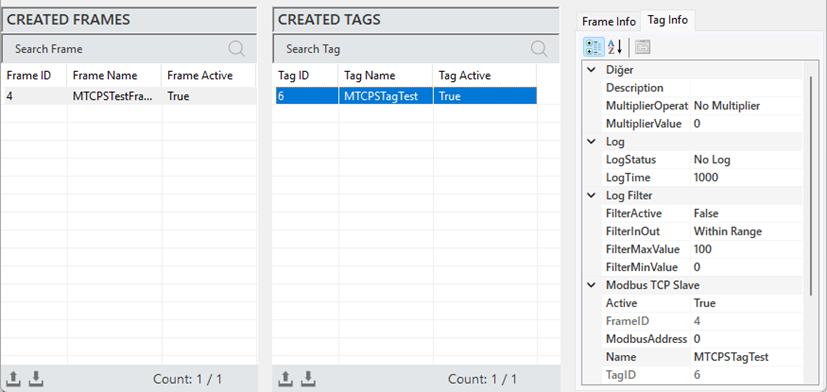
Figure 109 – Modbus TCP Slave Tag Info
The parameter descriptions are presented in the table below.
| "Description" | This is the label information field. |
|---|---|
| "Multiplier Operation" | Defines the mathematical operation. |
| "Multiplier Value" | Converts raw data into meaningful measurements using a multiplier. |
| "Log Status" | Specifies the data logging status of the label. |
| "Log Time" | The duration of the data logging period, specified in milliseconds. |
| "Filter Active" | Enables the filtering function for label data recording. |
| "FilterInOut" | Defines the filter function (whether the values are inside or outside the specified range). |
| "FilterMaxValue" | Specifies the maximum value for filtering. |
| "FilterMinValue" | Specifies the minimum value for filtering. |
| "Active" | Determines the active/inactive status of the label. |
| "Frame ID" | The unique identification of the selected frame. |
| "ModbusAddress" | Specifies the address used for communication of the label. |
| "Name" | The name of the label. |
| "Tag ID" | The unique identification number that defines the label in a figure. |
Table 12 – Modbus TCP Slave Tag Info
4.3 Modbus RTU Protocols
The Modbus RTU protocol is a serial communication protocol used for data exchange in industrial automation systems. This protocol operates over serial communication methods such as RS-232 or RS-485, enabling data exchange between a master device and one or more slave devices. Modbus RTU uses 16-bit words for data transmission and works with structured data formats like registers and digital inputs/outputs.
Modbus RTU Channel Creation
To add a channel in the Modbus RTU protocol, right-click within the "Created Channels" area in the tag editor and select "Add Channel.
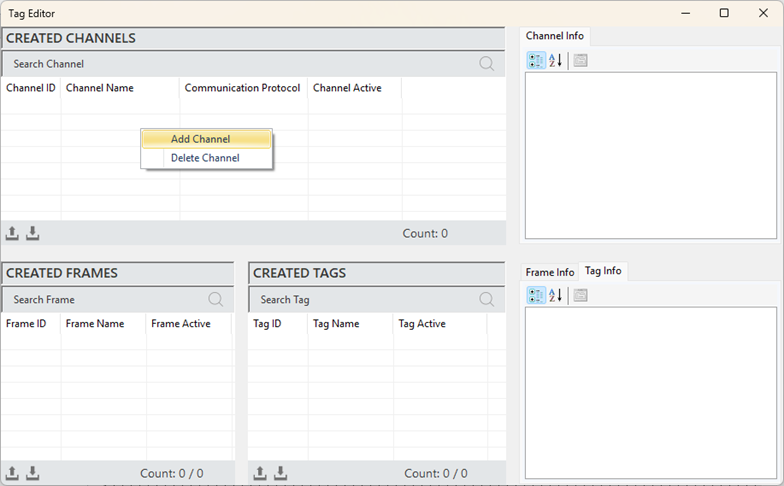
Figure 110 - Modbus RTU Channel Creation
In the window that opens, select the communication protocol as "Modbus RTU," specify the channel name, and then add the new channel.
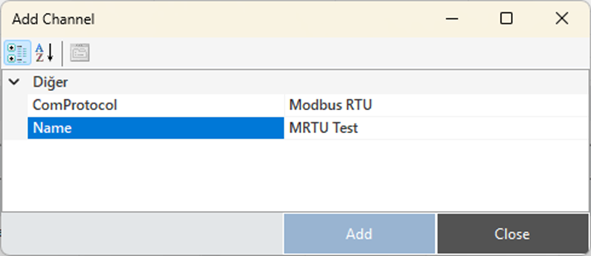
Figure 111 - Modbus RTU Channel Creation
Modbus RTU Channel Structure
When a channel is selected to access and make adjustments to its information, all details are reflected in the "Channel Information" panel.
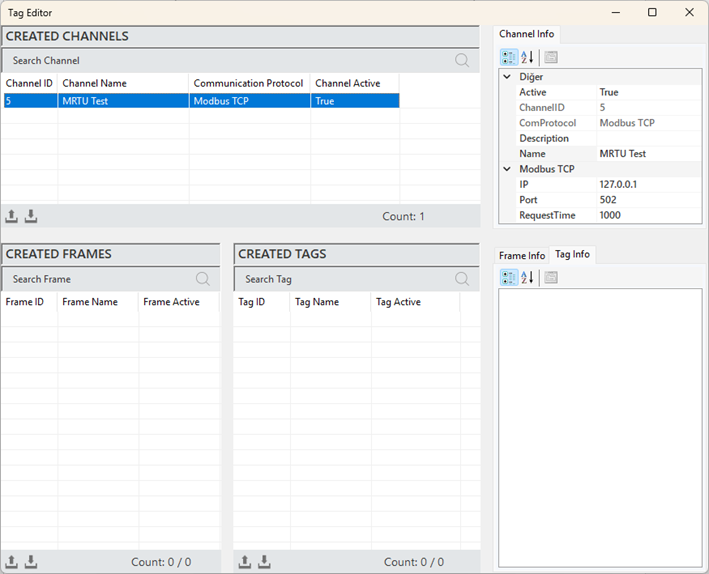
Figure 112 - Modbus RTU Channel Structure
The parameter descriptions are presented in the table below.
| “Active” | Determines the active/inactive status of the channel. |
|---|---|
| “Channel ID” | A unique identification number that defines the channel in a figure. |
| “Com Protocol” | Specifies the communication type. It is defined when the channel is created. |
| “Description” | The channel description. |
| “Name” | The name of the channel. |
| “Baudrate” | A measure that specifies the data transmission speed. |
| “Parity” | Adds an extra bit for error checking in data transmission. |
| “Port” | Specifies the port used for communication. |
| “Request Time” | The communication data response timeout, specified in milliseconds. |
| “Stop Bit” | Specifies the end of the data frame. |
Table 13 - Modbus RTU Channel Info
Modbus RTU Frame Creation
It is the process of defining a new frame to organize and manage the data structure. To create a frame, a channel must first be created. A channel is selected, and then right-clicking in the "Created Frames" area allows for adding a frame.
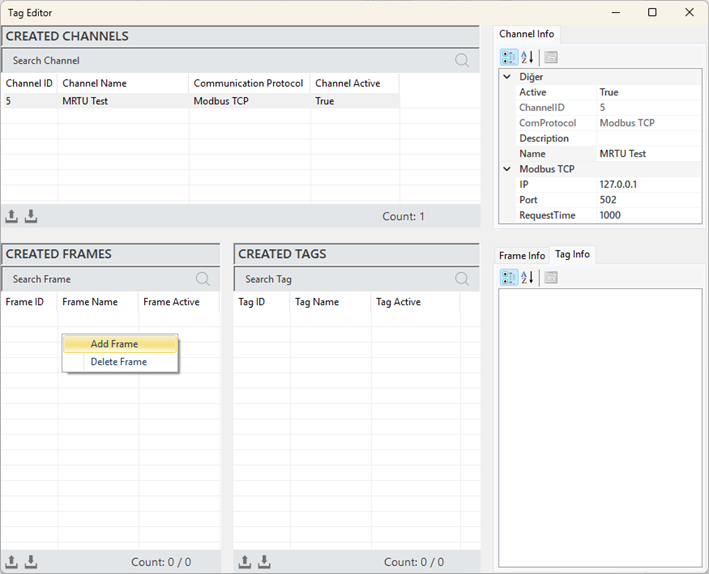
Figure 113 – Modbus RTU Frame Creation
In the window that opens, after entering the frame details, click "Add" to create the frame.
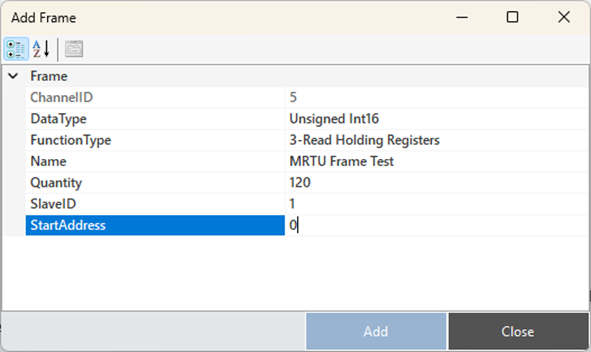
Figure 114 – Modbus RTU Frame Creation
Modbus RTU Frame Structure
When a frame is selected to access and make adjustments to its information, all details are reflected in the "Frame Information" panel.
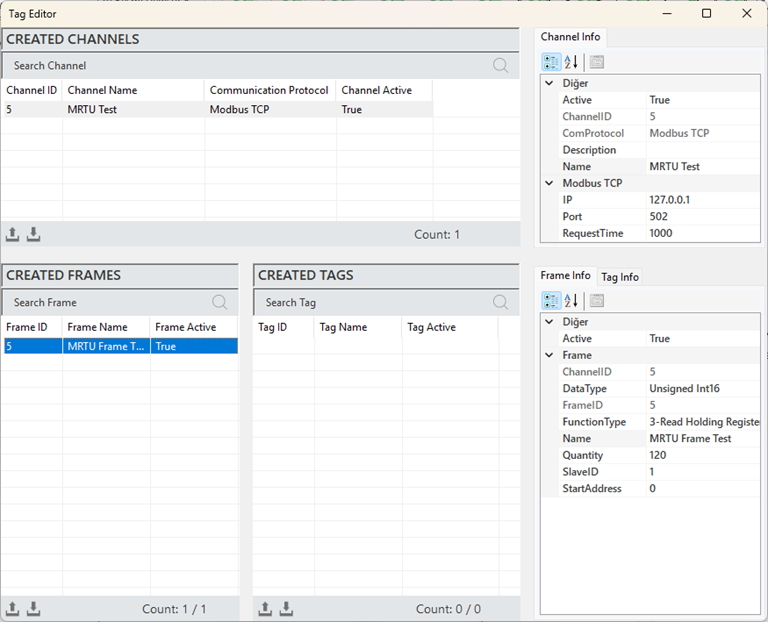
Figure 115 – Modbus RTU Frame Info
The parameter descriptions are presented in the table below.
| “Active” | Determines the active/inactive status of the frame. |
|---|---|
| “Channel ID” | A unique identification number that defines the frame in a figure. |
| “Data Type” | Specifies the data type of the frame. |
| “Function Type” | Specifies the function type of the frame. |
| “Name” | The name of the frame. |
| “Quantity” | The number of data (tags) in the frame. |
| “Slave ID” | The identification number of the device to communicate with. |
| “Start Address” | The address where the first data in the frame is located, and the starting address. |
Table 14 – Modbus RTU Frame Info
Modbus RTU Tag Creation
It is the process of creating a new label that represents a specific measurement or control data. To create a label, a frame must first be created. A frame is selected, and then right-clicking in the "Created Tags" area allows for adding a label.
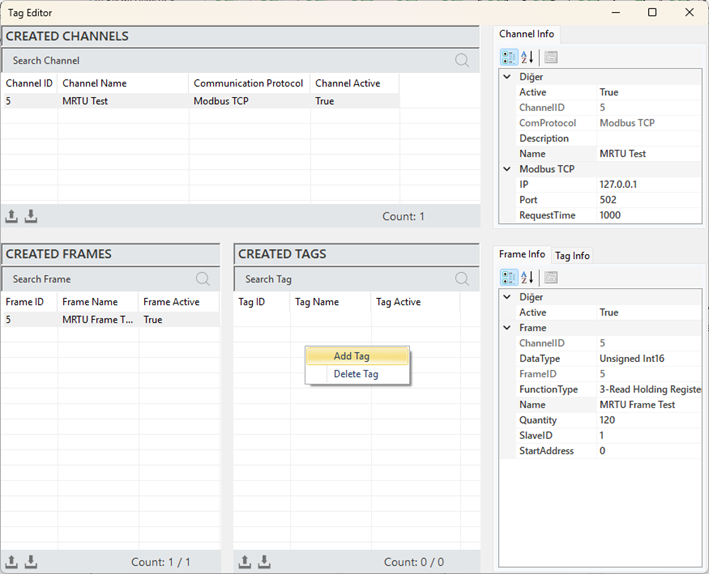
Figure 116 – Modbus RTU Tag Creation
In the window that opens, after entering the label details, click "Add" to create the label.
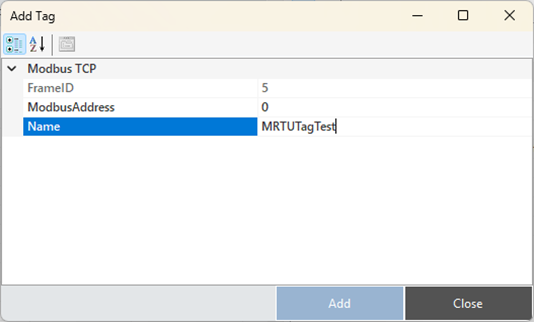
Figure 117 – Modbus RTU Tag Creation
Modbus RTU Tag Structure
When a label is selected to access and make adjustments to its information, all details are reflected in the "Label Information" panel.
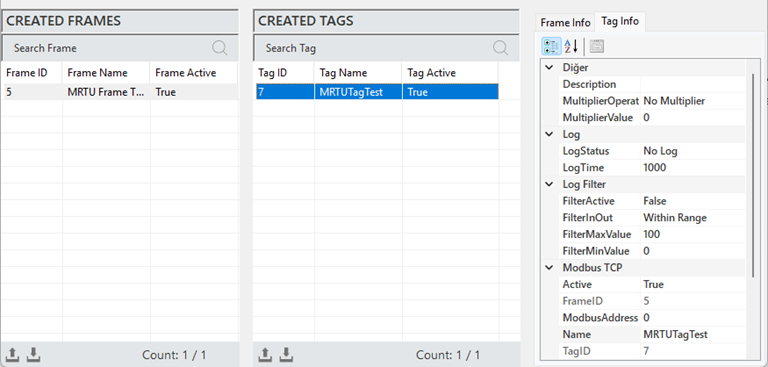
Figure 118 – Modbus RTU Tag Info
The parameter descriptions are presented in the table below.
| "Description" | The label information field. |
|---|---|
| "Multiplier Operation" | Defines the mathematical operation. |
| "Multiplier Value" | Converts raw data into meaningful measurements using a multiplier. |
| "Log Status" | Specifies the data logging status of the label. |
| "Log Time" | The data logging period, specified in milliseconds. |
| "Filter Active" | Enables the filtering function for label data recording. |
| "FilterInOut" | Defines the filter function for values within or outside the range |
| "FilterMaxValue" | Specifies the maximum value for filtering. |
| "FilterMinValue" | Specifies the minimum value for filtering. |
| "Active" | Determines the active/inactive status of the label. |
| "Frame ID" | The unique identification number of the selected frame. |
| "ModbusAddress" | Specifies the address used for communication of the label. |
| "Name" | The name of the label. |
| "Tag ID" | The unique identification number that defines the label in a figure. |
Table 15 – Modbus RTU Tag Info
4.4 Modbus RTU OVER TCP Protocol
Modbus RTU is a structure that enables the transmission of Modbus RTU messages over the TCP/IP (Transmission Control Protocol/Internet Protocol) communication protocol. It allows devices to connect over an Ethernet network.
Modbus RTU OVER TCP Channel Creation
To add a channel in the Modbus RTU OVER TCP Slave protocol, right-click within the "Created Channels" area and select "Add Channel".
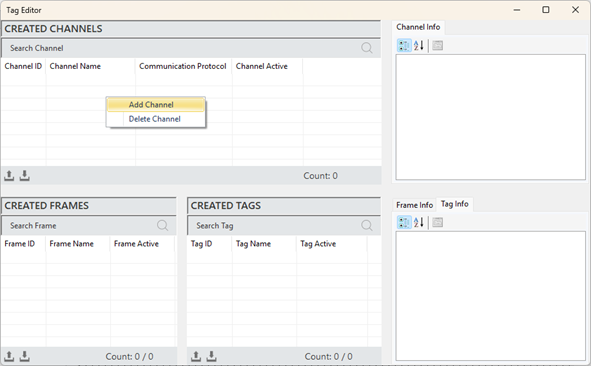
Figure 119 - Modbus RTU OVER TCP Channel Creation
In the window that opens, select the communication protocol as "Modbus RTU OVER TCP", specify the channel name, and then add the new channel.
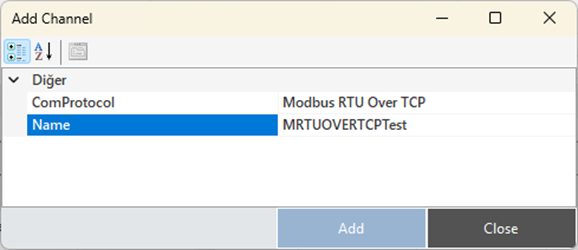
Figure 120 - Modbus RTU OVER TCP Channel Creation
Modbus RTU OVER TCP Channel Structure
When a channel is selected to access and make adjustments to its information, all details are reflected in the "Channel Information" panel.
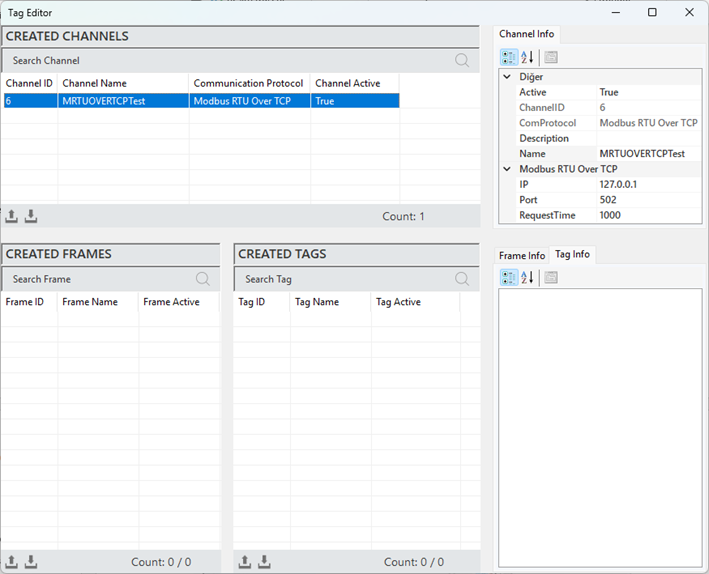
Figure 121 – Modbus RTU OVER TCP Channel Info
The parameter descriptions are presented in the table below.
| “Active” | Determines the active/inactive status of the channel. |
|---|---|
| “Channel ID” | A unique identification number that defines the channel in a figure. |
| “Com Protocol” | Specifies the communication type. It is defined when the channel is created. |
| “Description” | The channel description, defined according to the need. |
| “IP” | Specifies the IP address for communication. |
| “Port” | Specifies the port used for communication. |
| “Request Time” | The communication data response timeout, specified in milliseconds. |
Table 16 - Modbus RTU OVER TCP Channel Info
Modbus RTU OVER TCP Frame Creation
It is the process of defining a new frame to organize and manage the data structure. To create a frame, a channel must first be created. A channel is selected, and then right clicking in the "Created Frames" area allows you to add a frame.
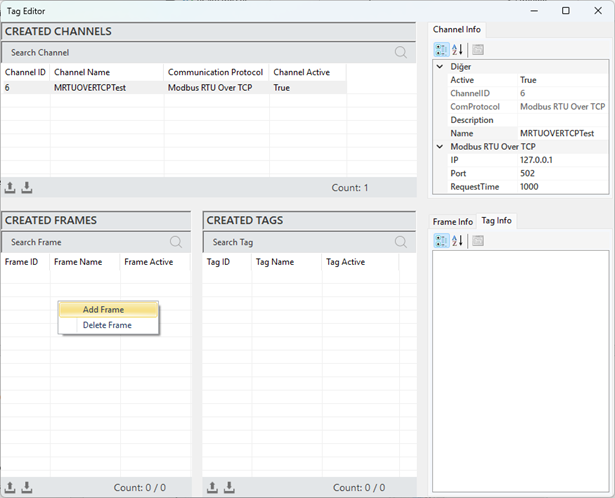
Figure 122 - Modbus RTU OVER TCP Frame Creation
In the window that opens, after entering the frame details, click "Add" to create the frame.
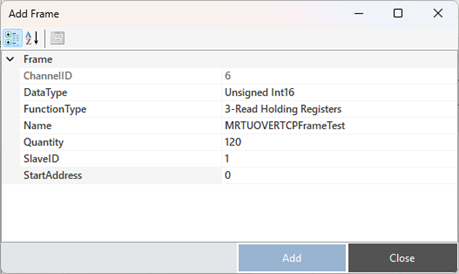
Figure 123 - Modbus RTU OVER TCP Frame Creation
Modbus RTU OVER TCP Frame Structure
When a frame is selected to access and make adjustments to its information, all details are reflected in the "Frame Information" panel.
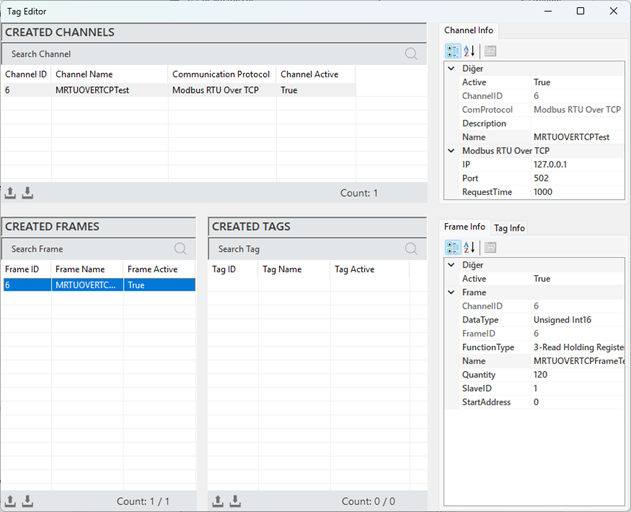
Figure 124 - Modbus RTU OVER TCP Frame Info
The parameter descriptions are presented in the table below.
| “Active” | Determines the active/inactive status of the frame. |
|---|---|
| “Channel ID” | A unique identification number that defines the frame in a figure. |
| “Data Type” | Specifies the data type of the frame. |
| “Function Type” | Specifies the function type of the frame. |
| “Name” | Name of the frame. |
| “Quantity” | The number of data (tags) in the frame. |
| “Slave ID” | The identification number of the device for communication. |
| “Start Address” | The address of the first data in the frame, also the starting address |
Table 17 - Modbus RTU OVER TCP Frame Info
Modbus RTU OVER TCP Tag Creation
It is the process of creating a new label that represents a specific measurement or control data. To create a label, a frame must first be created. A frame is selected, and then right-clicking in the "Created Tags" area allows you to add a label.
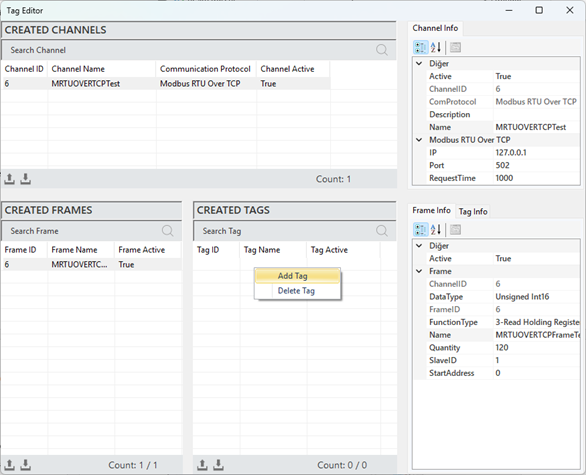
Figure 125 - Modbus RTU OVER TCP Tag Creation
In the window that opens, after entering the label details, click "Add" to create the label.
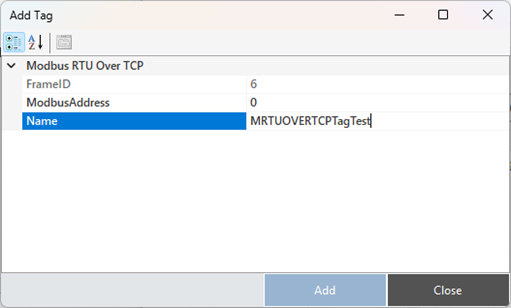
Figure 126 - Modbus RTU OVER TCP Tag Creation
Modbus RTU OVER TCP Tag Structure
When a label is selected to access and make adjustments to its information, all details are reflected in the "Label Information" panel.
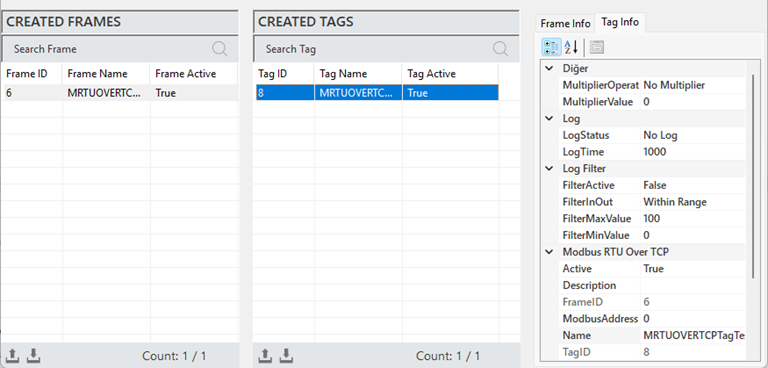
Figure 127 - Modbus RTU OVER TCP Tag Info
The parameter descriptions are presented in the table below.
| "Description" | The label information field. |
|---|---|
| "Multiplier Operation" | Used to perform any mathematical operation on the label data. |
| "Multiplier Value" | Specifies the value in the operation to be applied to the label. |
| "Log Status" | Indicates the label's log status. Select "Periodic" to activate, or "No Log" to deactivate |
| "Log Time" | The duration for recording label data, specified in milliseconds. |
| "Filter Active" | Activates the filtering function when label data is being recorded. |
| "FilterInOut" | Defines whether the filter value should be within or outside the specified range. |
| "FilterMaxValue" | Specifies the maximum value in the filter. |
| "FilterMinValue" | Specifies the minimum value in the filter. |
| "Active" | Determines the active/inactive status of the label. |
| "Frame ID" | The unique ID of the selected frame, automatically assigned by the editor |
| "ModbusAddress" | Specifies the address for communication with the label. |
| "Name" | The name of the label. |
| "Tag ID" | The identification number that uniquely defines the label in a figure. |
Table 18 - Modbus RTU OVER TCP Tag Info
4.5 MQTT Client Protocol
The MQTT (Message Queuing Telemetry Transport) protocol is a communication protocol used for data exchange in IoT applications, known for its lightweight structure. Designed to operate on networks with low bandwidth, MQTT adopts the "publish/subscribe" model, enabling asynchronous data exchange between devices. The protocol operates through a central broker, where messages are sent, enhancing the scalability of the system.
4.5.1 Mosquitto
For effective communication via MQTT in the Omnivex SCADA software, both the MQTT Broker and the SCADA server must run on the same computer. This setup is critical for ensuring the seamless operation of the system’s data communication and control mechanisms.
In this context, it is essential to first install the Mosquitto program on the computer where the SCADA server will be used. Mosquitto serves as the MQTT Broker, providing reliable data transmission between devices and facilitating the integration of systems.
4.5.2 Mosquitto Installation
To install the Mosquitto Broker, download the appropriate version from the official website or click here to access the download link. Once downloaded, begin the installation process on your computer.
In the installation wizard, click "Next" on the first page to proceed.
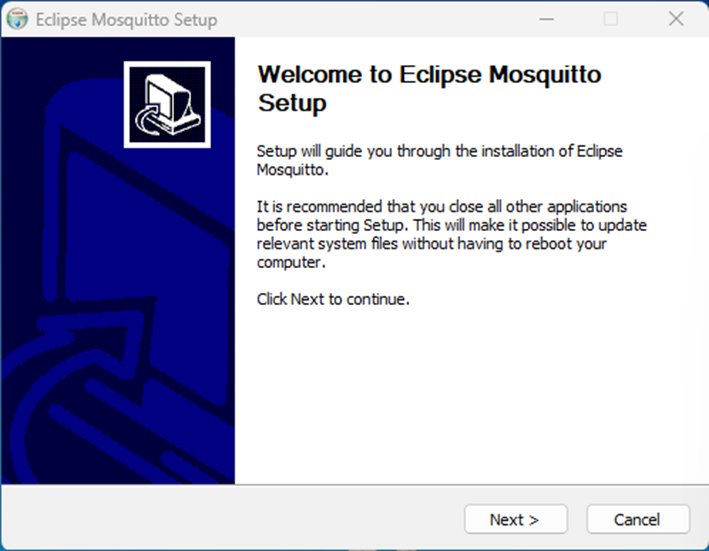
Figure 128 - Mosquitto Installation
Select the features you want to install for Mosquitto and click "Next" to proceed.
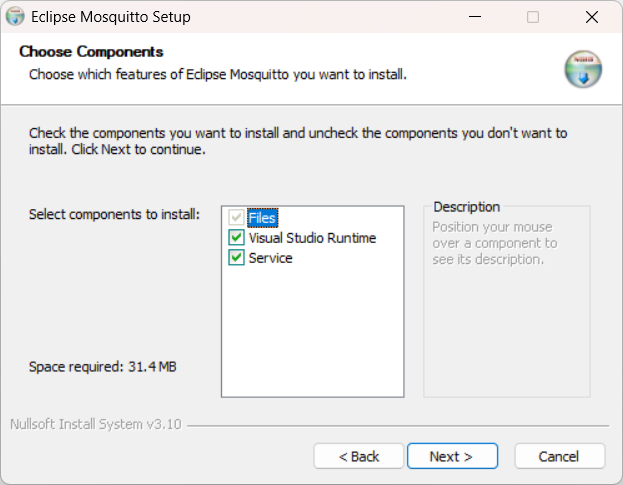
Figure 129 - Mosquitto Installation
Select the directory where you want to install Mosquitto and click "Install" to begin the installation process.
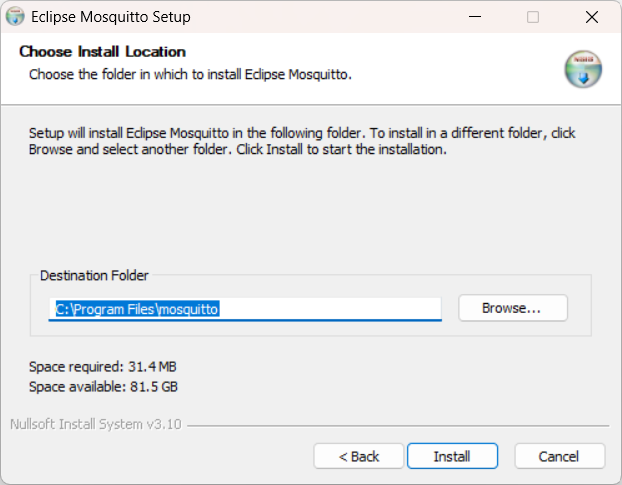
Figure 130 - Mosquitto Installation
The installation wizard will begin.
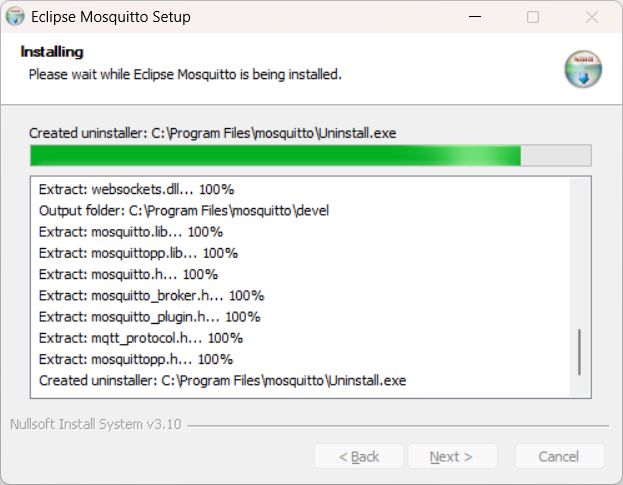
Figure 131 - Mosquitto Installation
Once the installation is complete, click “Finish” to exit the wizard.
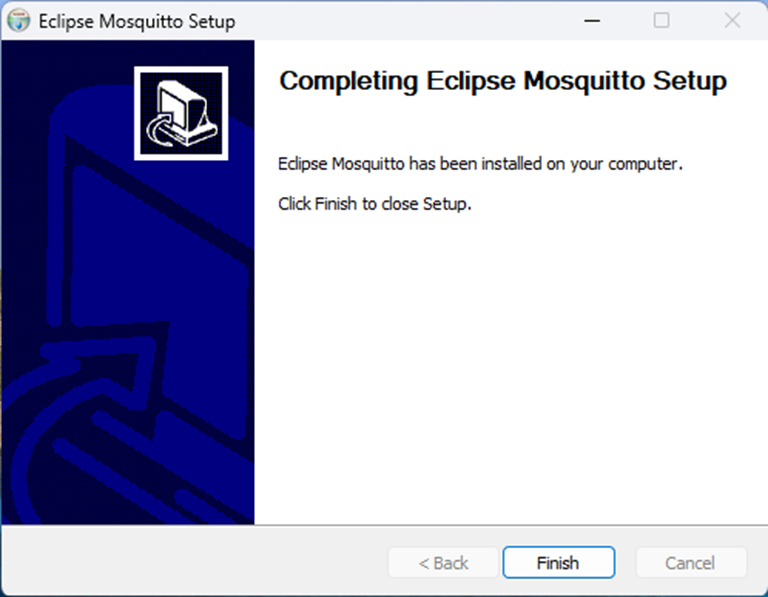
Figure 132 - Mosquitto Installation
4.5.3 Mosquitto Configuration Settings
Configuring Mosquitto properly is crucial for its use within the Omnivex SCADA system. Below are the key steps and settings:
The Mosquitto configuration file is typically located at /etc/mosquitto/mosquitto.conf. Open this file using a text editor.
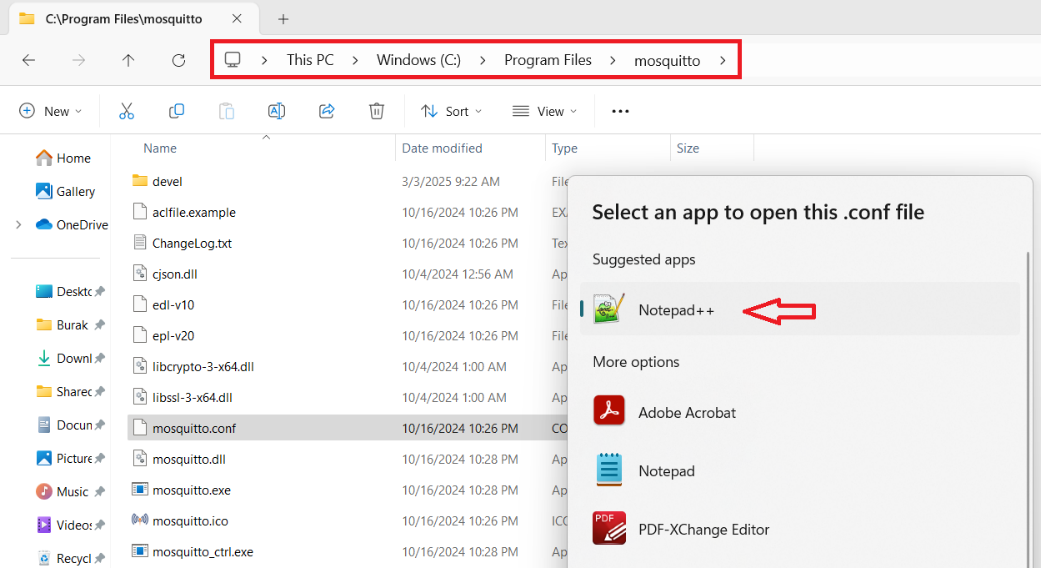
Figure 133 - Mosquitto Configuration
The file's appearance when opened in Notepad++ is as follows:
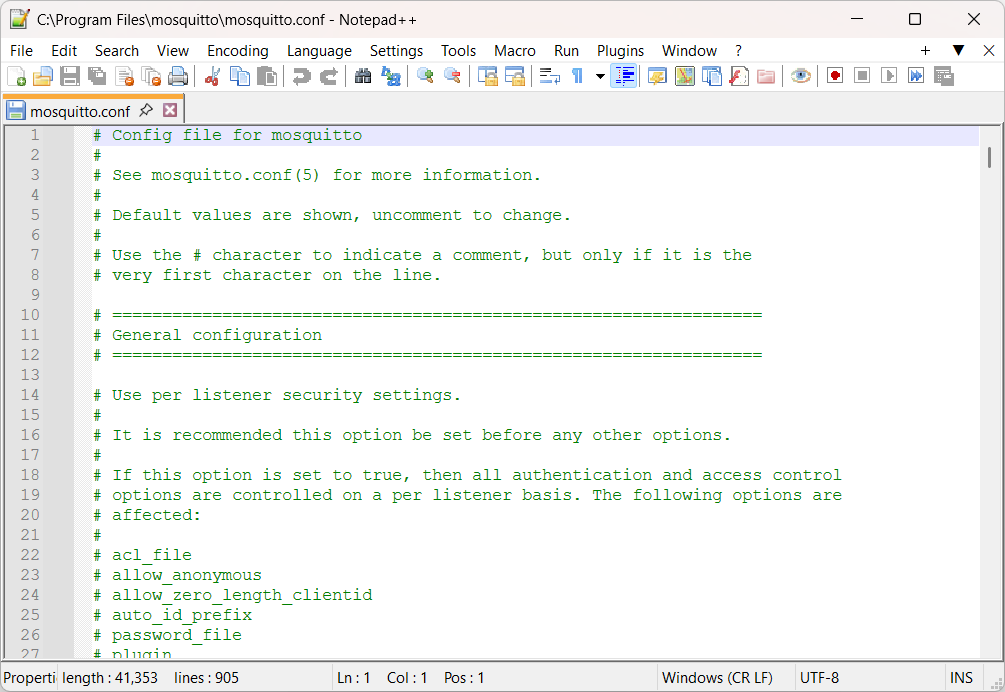
Figure 134 - Mosquitto Configuration
In the file, use the Ctrl+F command to find the "Security" section, and make the following changes under this heading:
For the security setting: Change the "false" value in the command “#allow_anonymous false” to “true”.
For the port setting: Add the command “#listener 1883” immediately below the line above.
By default, Mosquitto uses port 1883. If you wish to use a different port, you can specify it.
The appearance after these settings will be as follows:
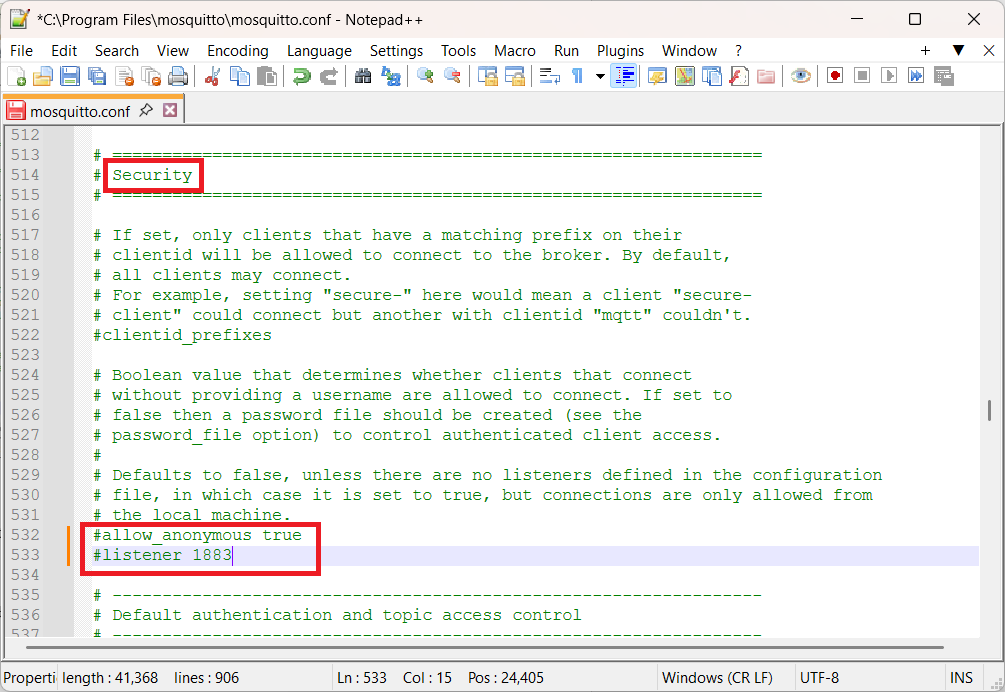
Figure 135 - Mosquitto Configuration
By following these steps, you can integrate Mosquitto with your Omnivex SCADA system, and the default MQTT port 1883 will be defined in the Broker settings as well.
After making the necessary changes, you can save the file and exit.
4.5.4 Running Mosquitto
Once the configuration settings are complete, follow these steps to run Mosquitto:
Go to Start > Search and type “cmd”. In the search results, right-click on Command Prompt and select Run as Administrator.
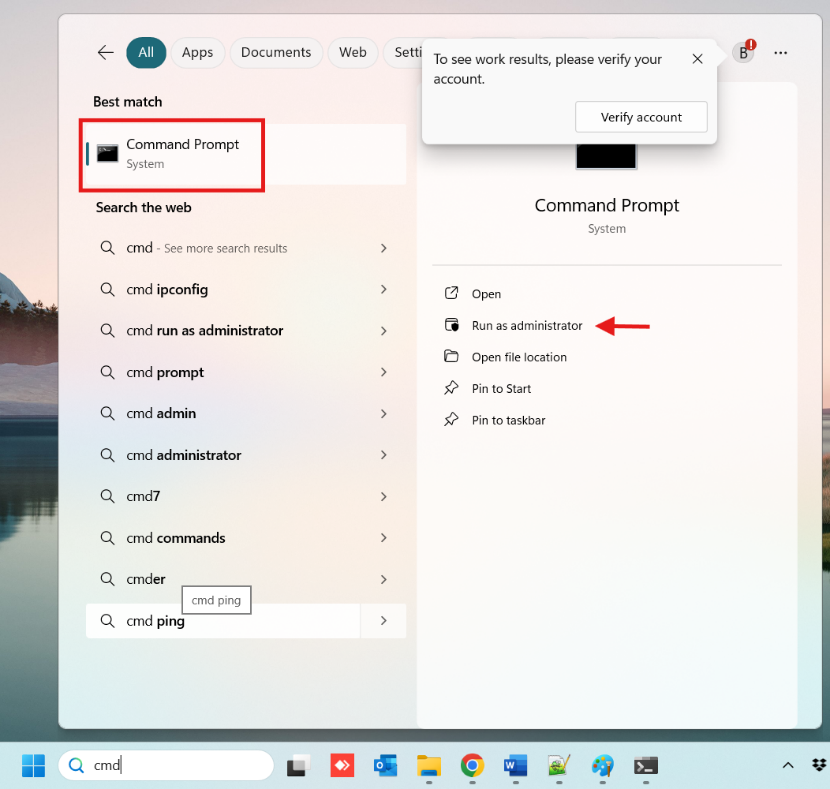
Figure 136 – Running Mosquitto
In the opened window, type the command “net start mosquitto” and press the Enter key. Once you receive the notification "Mosquitto Broker service has started successfully," Mosquitto will be running.
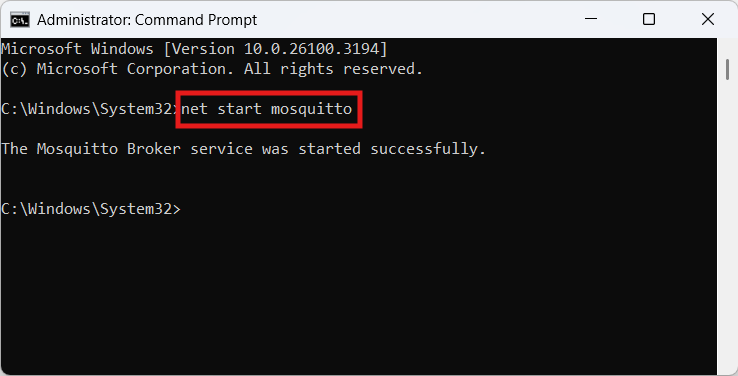
Figure 137 - Running Mosquitto
To stop Mosquitto, type the command "net stop mosquitto" in the Command Prompt window and press the Enter key. The program will stop, and you will receive the notification "Mosquitto Broker service has been stopped successfully".
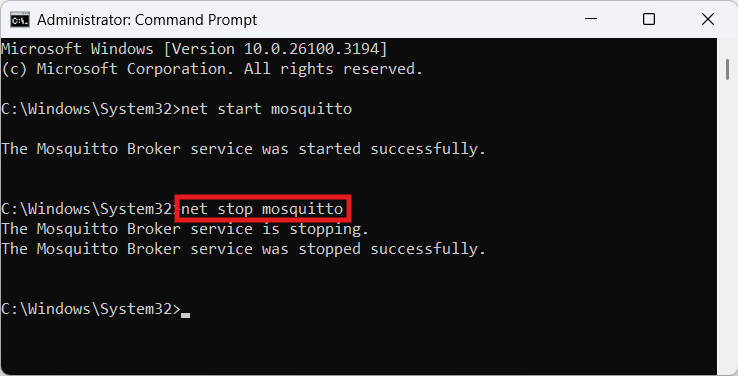
Figure 138 – Running Mosquitto
Creating an MQTT Client Channel
To add a channel in the MQTT Client protocol, right-click within the "Created Channels" area and select "Add Channel".
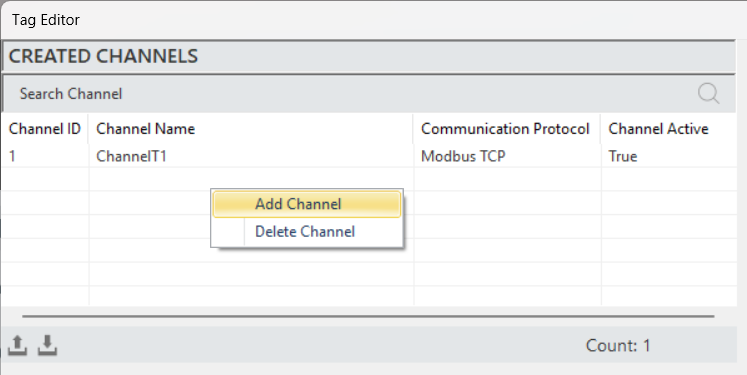
Figure 139 - MQTT Channel Creation
In the opened window, select the communication protocol "MQTT Client," specify the channel name, and then add the new channel.
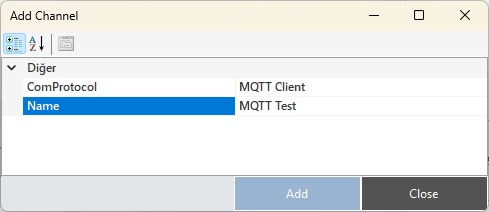
Figure 140 - MQTT Channel Creation
MQTT Channel Structure
To access and make modifications to the channel information, when a channel is selected, all the details are reflected in the "Channel Information" panel.
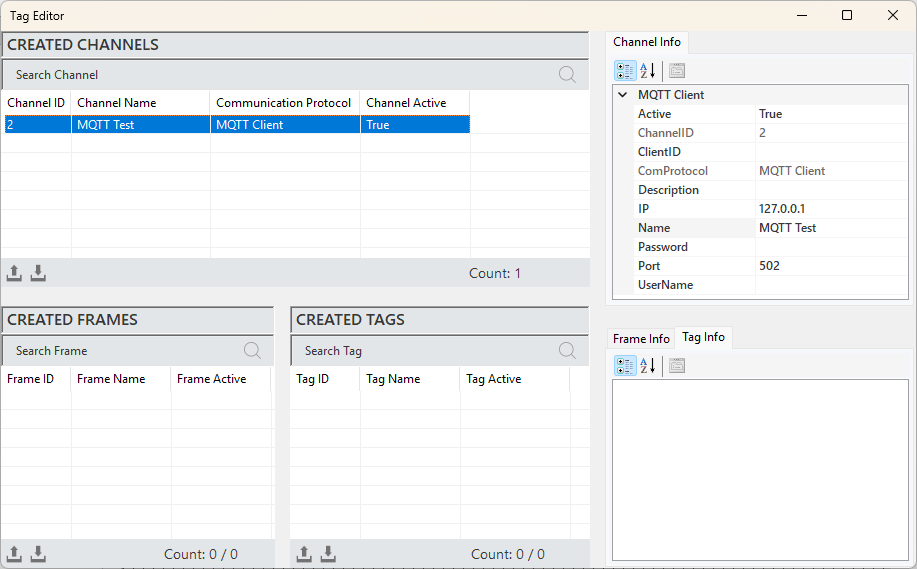
Figure 141 – MQTT Channel Info
The parameter descriptions are presented in the table below.
| “Active” | Determines the active/inactive status of the channel. |
|---|---|
| “Channel ID” | A unique identification number that defines the channel in a figure. |
| “Client ID” | A unique identifier used to identify the client when connecting to the broker |
| “Com Protocol” | The communication protocol type. It is defined when creating the channel. |
| “Description” | The description of the channel, which is defined based on requirements. |
| “IP” | The address of the MQTT Broker on the network it is connected to. |
| “Name” | The name of the channel. |
| “Password” | The password used to authenticate a secure connection with the broker. |
| “Port” | The port information for communication. |
| “User Name” | The username used to authenticate a secure connection with the broker. |
Table 19 – MQTT Channel Info
MQTT Frame Creation
It is the process of defining a new frame to organize and manage the data structure. To create a frame, a channel must first be created. A channel is selected, and by right-clicking in the “Created Frames” area, the option to add a frame is clicked.
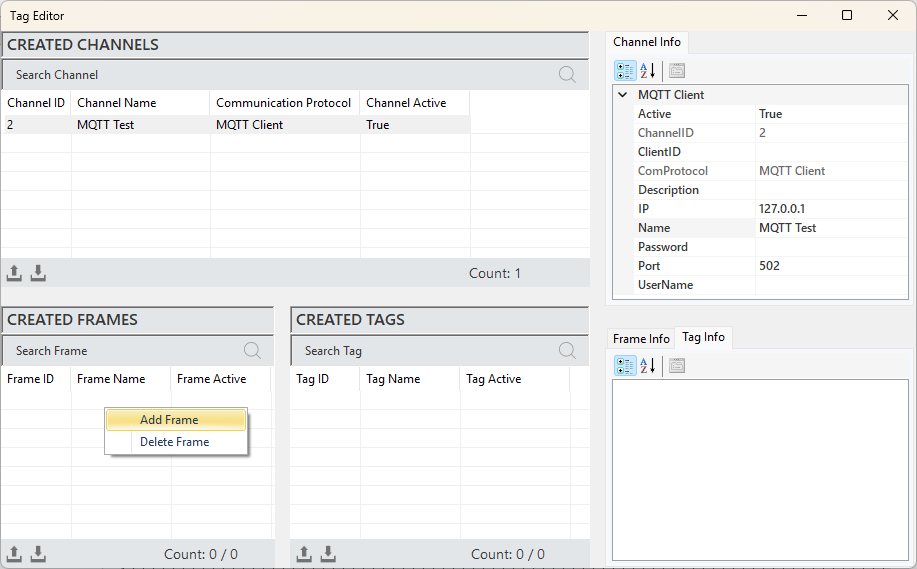
Figure 142 – MQTT Frame Creation
After entering the frame information in the opened window, click "Add" to create the frame.
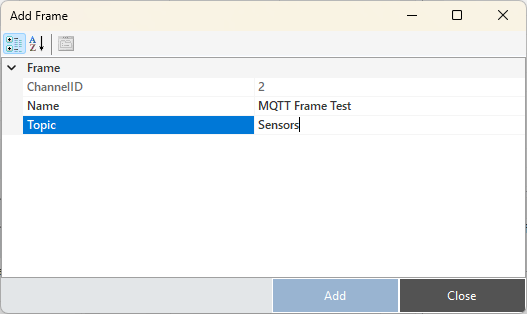
Figure 143 – MQTT Frame Creation
MQTT Frame Structure
When a frame is selected, all information is displayed in the "Frame Information" panel, allowing access to and modifications of the frame details.
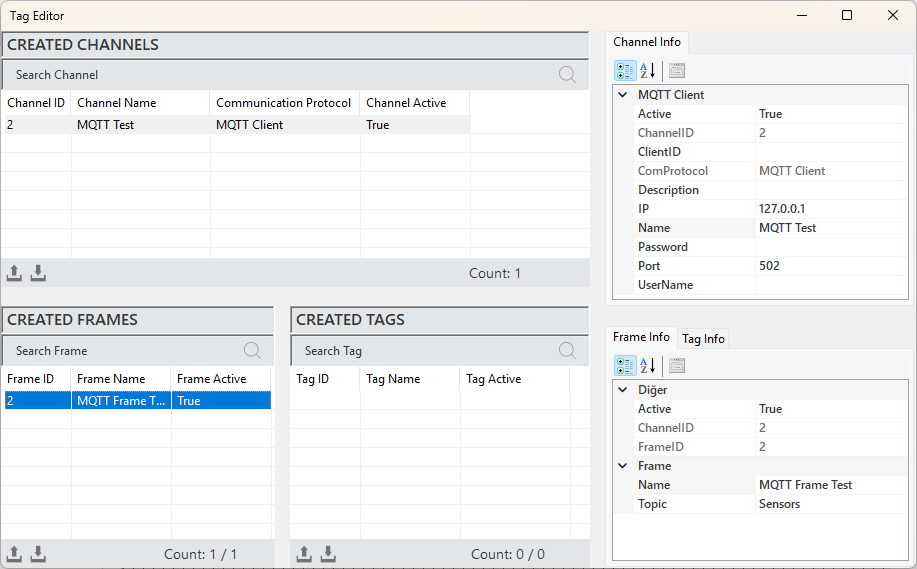
Figure 144 – MQTT Frame Info
The explanations of these parameters are presented in the table below.
| “Active” | Determines the active/inactive status of the frame. |
|---|---|
| “Channel ID” | The identification number that uniquely defines the channel in a figure. |
| “Frame ID” | The Frame ID information. |
| “Name” | The name of the frame. |
| “Topic” | The topic is a string that defines the subject of a message |
Table 20 – MQTT Frame Info
MQTT Tag Creation
It is the process of creating a new tag that represents a specific measurement or control data. In order to create a tag, a frame must first be created. A frame is selected, and then right-clicking in the "Created Tags" area and selecting "Add Tag" will initiate the process.
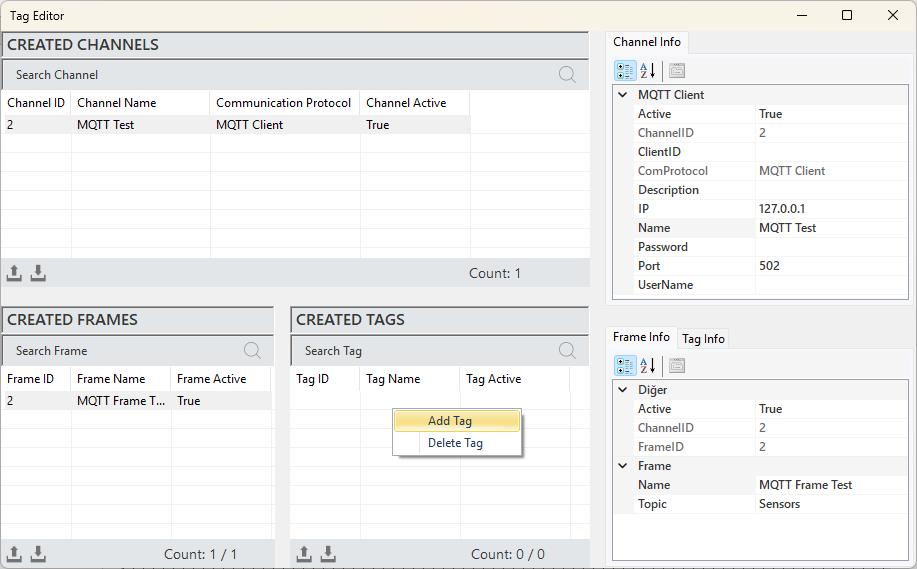
Figure 145 – MQTT Tag Creation
After entering the tag information in the opened window, click "Add" to create the tag.
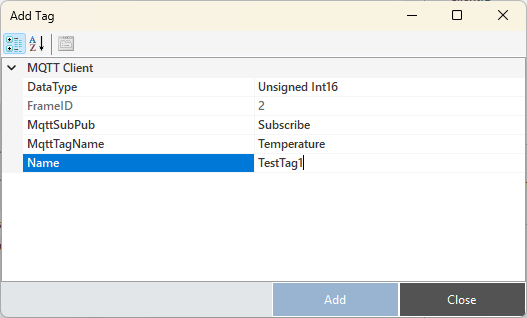
Figure 146 – MQTT Tag Creation
MQTT Tag Structure
When a tag is selected, all information is reflected in the "Tag Information" panel for access and modifications.
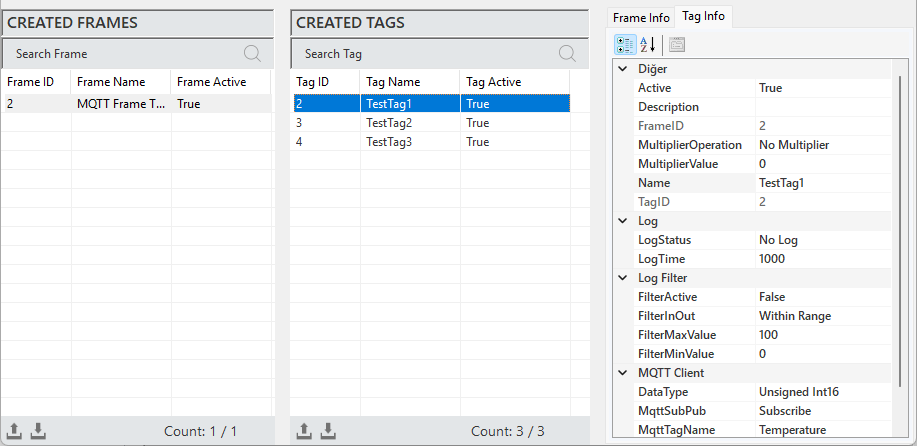
Figure 147 – MQTT Tag Info
The explanations of these parameters are provided in the table below.
| “Active” | Determines whether the tag is active or inactive. |
|---|---|
| “Description” | Information field for the tag. |
| “Frame ID” | Unique identification number of the selected frame. |
| “Multiplier Operation” | Defines the mathematical operation. |
| “Multiplier Value” | Specifies the value for the operation applied to the tag. |
| “Name” | The name of the tag. |
| “Tag ID” | A unique identification number that defines the tag in a figure. |
| “Log Status” | Determines the log status of the tag data. |
| “Log Time” | The time period for data logging, specified in milliseconds. |
| “Filter Active” | Enables the filtering function for the tag data logging. |
| “FilterInOut” | Defines the filter function for values within or outside a range |
| “FilterMaxValue” | Specifies the maximum value for filtering. |
| “FilterMinValue” | Specifies the minimum value for filtering. |
| “Data Type” | The data type of the tag. |
| “MqttSubPub” | Describes the basic MQTT functions for receiving and sending data. |
| “MqttTagName” | A name that identifies a specific data point or variable |
Table 21 – MQTT Tag Info
